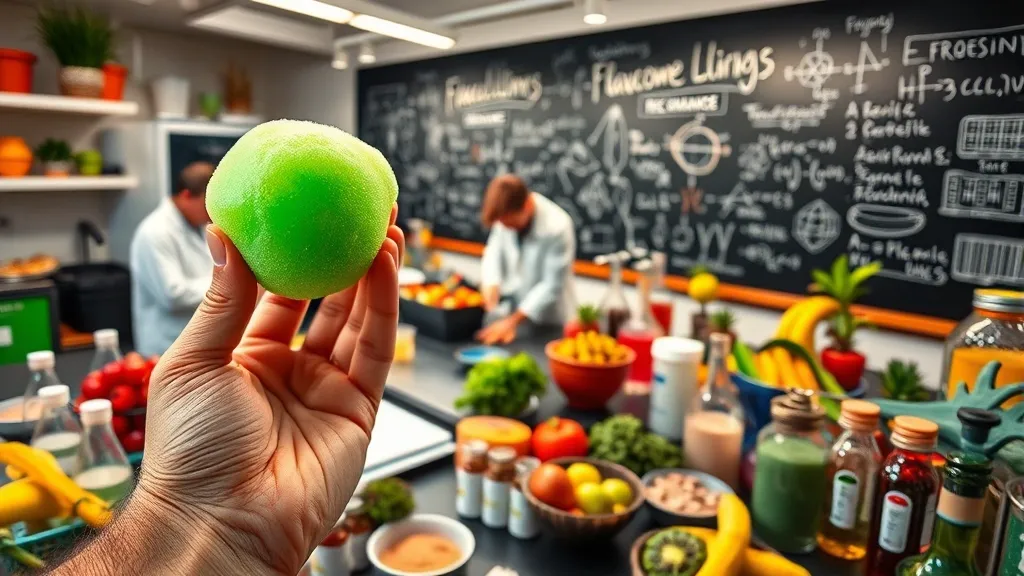The Alchemy of Flavor: Transforming Ingredients into Culinary Gold
You ever think about how a simple tomato can turn into a mouthwatering marinara sauce? It’s almost magical, right? Well, that’s the alchemy of flavor we’re diving into here. Food science and technology are like the secret wizards behind the curtain, pulling the strings to make our meals taste amazing.
First off, let’s talk about flavor. It’s not just about throwing some spices in a pot and hoping for the best. Nope, it’s way more complex than that! Scientists have uncovered that flavor is a combination of taste, smell, and even texture. So, when you’re munching on a perfectly cooked steak, it’s not just the seasoning that makes it great; it’s also the aroma wafting through the air and that juicy tenderness.
Now, here’s where it gets really interesting. Thanks to advances in food technology, we can manipulate these elements in ways that blow our minds. Ever heard of sous-vide cooking? It’s basically cooking food in a vacuum-sealed bag in a water bath at a precise temperature. Sounds fancy, right? But what it really does is keep all those delicious juices and flavors locked in. You end up with a steak that’s cooked to perfection, tender as a cloud, and bursting with flavor. No more dry, overcooked meat for us!
And let’s not forget about fermentation. Oh man, I could go on about this for hours. Fermented foods like kimchi and yogurt not only taste awesome but they also bring a whole new level of depth to dishes. It’s like a flavor explosion happens, and your taste buds are just throwing a party! Plus, they’re good for your gut, so it’s a win-win.
- Flavor Pairing: Ever tried chocolate with chili? Mind-blowing!
- Texture Matters: Crispy edges on a pizza? Yes, please!
- Temperature Play: Cold ice cream on a warm pie? The best combo!
So, what’s the takeaway here? Food science isn’t just for lab coats and test tubes; it’s about unlocking new flavors and making our meals more enjoyable. Whether you’re a home cook or a seasoned chef, understanding the science behind what you eat can transform your cooking game. Who knew that a sprinkle of knowledge could turn your kitchen into a culinary goldmine? Now, let’s get cooking!
From Lab to Table: The Rise of Precision Agriculture and Sustainable Practices
So, let’s talk about precision agriculture. It sounds all fancy and techy, right? But honestly, it’s just about using the latest tools and tech to grow food more efficiently and sustainably. I mean, who wouldn’t want their veggies to be the best they can be? Imagine your tomatoes strutting around like they own the place—proud, juicy, and totally perfect for that summer salad!
Here’s the scoop: farmers are now using drones, sensors, and all sorts of data to keep tabs on their crops. It’s like giving them a superpower! These tools help them figure out what their plants need—whether it’s more water, nutrients, or maybe just a little pep talk. The result? Less waste, more yield, and food that’s better for us and the planet. Win-win, right?
- Less Waste: With precision tools, farmers can reduce overuse of water and fertilizers. That’s a big deal!
- Better Crop Management: Sensors can detect diseases early, which means healthier plants and tastier food.
- Sustainable Practices: By using data to guide decisions, farmers can adopt practices that are kinder to the earth.
But hold up—this isn’t just about tech for the sake of tech. It’s also about sustainability. People are more aware than ever about where their food comes from, and they wanna make sure it’s grown in a way that won’t harm the environment. You know, like not spraying chemicals all over the place. It’s kinda like how we all try to recycle and use less plastic, but on a much bigger scale.
Plus, there’s a bit of a community vibe to it. Farmers are sharing data and best practices with each other. It’s like a giant group chat, but instead of gossiping about who’s dating who, they’re talking about soil health and crop rotations. I mean, who knew agriculture could be so social?
In a nutshell, precision agriculture is shaking things up in a big way. As we dive deeper into food science and technology, we’re not just improving how we grow food; we’re also making strides towards a more sustainable future. And that’s something we can all feel good about. So, next time you bite into a perfectly ripe peach, you can thank a farmer—and maybe a drone or two—for that deliciousness!
Tech Meets Taste: How Innovations are Shaping Our Eating Experience
Let’s be real for a sec: food tech is kinda wild these days. I mean, who would’ve thought we’d be using apps to figure out what to eat or even grow our own food with the help of some fancy gadgets? It’s like we’re living in a sci-fi movie where robots might just whip up dinner for us one day. But, until that happens, let’s dive into how all these innovations are changing the way we munch.
First off, there’s the whole world of smart appliances. Ever heard of a smart oven? These bad boys can connect to your Wi-Fi and be controlled from your phone. You can preheat it while you’re stuck in traffic. No more frantic dashes to the kitchen when you realize you forgot to turn it on! Plus, they often come with built-in recipes, so if you’re like me and can’t figure out how to boil water without burning it, this is a game changer.
Then there’s food delivery tech. I mean, thank you, internet gods, for Grubhub and its friends! It’s a dream come true for those of us who sometimes just can’t even with cooking. And let’s not forget about meal kits. They’re like a subscription box for foodies who want to pretend they’re gourmet chefs. Just don’t ask me to chop an onion without crying. Seriously, it’s a disaster.
Now, let’s talk about how tech is helping us eat healthier. Apps like MyFitnessPal and Noom are great for tracking what we consume, and they can even help us understand our eating habits. It’s like having a personal trainer in your pocket. I’ve been trying to eat better lately, and these apps keep me honest… or at least they try to! But honestly, it’s hard to resist that late-night pizza craving.
And we can’t overlook lab-grown meat! Yep, you heard that right. The science behind growing meat in a lab is getting super advanced, and it could change the game for sustainability and animal welfare. I mean, who wouldn’t wanna eat a burger that doesn’t involve a trip to the farm? Just think about it: guilt-free burgers! Count me in!
So, in a nutshell, technology is making our eating experience not just easier but also more interesting. From smart kitchens to health tracking, it’s like a whole new world of flavors and possibilities. Sure, it might not replace the good ol’ family meals or the joy of cooking with friends, but it definitely adds a sprinkle of fun to the mix. Who knows what’s next? Maybe a robot chef that can finally get my order right!
The Future Feast: Imagining a World Where Food Science Redefines Our Palates
Okay, let’s get real for a minute. The world of food is changing fast, and if you’re anything like me, you might be a little overwhelmed but also super excited. I mean, who would’ve thought we’d be having lab-grown burgers and meatless steaks on our plates? It’s like we jumped straight into a sci-fi movie, and I’m here for it.
Food science isn’t just about making things taste better (although that’s a huge part of it). It’s about creating sustainable options for our ever-growing population. Imagine a future where we can grow food in urban areas using vertical farms, or where we can 3D print our meals. Sounds wild, right? But it’s happening, and I can’t help but think about how cool it would be to have a pizza made right in front of me, layer by layer, from a printer! I mean, sign me up!
- Flavor Innovations: Scientists are playing with flavor compounds to make food taste like things we’ve never even thought of. Ever tried a berry-flavored mushroom? Yeah, me neither, but it could happen!
- Nutritional Upgrades: We might be able to tweak our food to pack in more vitamins and minerals without changing the taste. Imagine eating a donut that’s actually good for you. Where do I get that?
- Waste Reduction: Food science is also tackling the giant problem of food waste. New techniques can help us use every part of a plant or animal, making our meals not just tastier but also more responsible.
But it’s not all rainbows and sunshine. There’s a bit of skepticism about all these changes. Some folks are worried about what goes into our food, and I totally get that. I mean, I’m still a little hesitant about the idea of eating something that was grown in a lab. It feels… unnatural? But then again, so does eating a hot dog sometimes, right?
In the end, the future of food looks pretty exciting, and maybe a little weird. It’s all about balance—embracing new tech while still keeping the roots of traditional cooking alive. We’re on the brink of a culinary revolution, and I can’t wait to see where it takes us. Just don’t forget to invite me to the dinner party!



